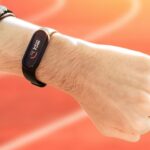Smart wearables (like fitness bands, ECG watches, and glucose monitors) are quietly fixing bad habits, catching diseases early, and cutting ER visits. By 2025, 63% of adults use wearables to track health—not just steps, but blood sugar, stress, and even early signs of Parkinson’s. Here’s how these gadgets are rewriting the rules of healthcare and reshaping daily habits.
The digital wrist-accessible devices known as smartwatches provide more functionality than simple fashionable technology products. Most tech workers underestimate the benefits of smartwatches offer. Moving forward let us investigate how these smartwatch devices address daily hurdles and achieve their goal of enhancing productivity while enhancing personal wellness that IT professionals are overlooking.
Why This Matters
Think of wearables as your 24/7 health bodyguard. They’re tackling two big problems:
—————————–Recommendations; Please continue reading below——————————
 ASUS Chromebook C223 11.6″ HD Laptop Shop Now
ASUS Chromebook C223 11.6″ HD Laptop Shop Now
This Asus HD Laptop is an amazon’s choice for ‘chrome computer laptop’ is reviewed by 980+ reviewers that is available at only $249.99. It is ready for productivity and performance while being on the go or travelling, with speedy performance, robust security, and convenience for the user. This laptop has Lightweight 2.2 pound body and with thin and premium metallic finish for a sleek appearance having 11.6 inch HD 1366×768 Anti-Glare Display. The machine is powered by the Intel Celeron N3350 Processor (2M Cache, up to 2.4GHz) for fast and snappy performance including 4 GB DDR3 RAM; 32GB eMMC hard drive; No CD or DVD drive with it. Learn more about this product >>>
- Reactive healthcare: Most folks ignore symptoms until it’s too late.
- Lifestyle diseases: 70% of chronic illnesses (diabetes, heart issues) are preventable with early action.
Wearables flip the script by giving real-time nudges before disaster strikes.

WHOOP 4.0 with 12 Month Subscription – Wearable Health, Fitness & Activity Tracker – Continuous Monitoring, Performance Optimization, Heart Rate Tracking – Improve Sleep, Strain, Recovery, Wellness Shop Now
WHOOP is a unique wearable fitness device that offers continuous monitoring of physiological data, including heart rate, respiratory rate, resting heart rate, heart rate variability, skin temperature, blood oxygen levels, daily activity and sleep so users can better understand their overall health and wellness status and track their progress over time.
WHOOP is insight-driven, providing users with clear next steps and a science-backed approach so they can understand and improve their overall health and optimize performance. Track and log your daily behaviors like activity, diet, alcohol consumption, stress levels, caffeine intake and more with the WHOOP Journal. WHOOP then calculates which behaviors help or hurt your sleep and recovery most, making it easier to stick with healthy habits.
5 Ways Wearables Are Changing Life (and Saving Lives)
1. Early Disease Detection
- Problem: Most cancers and heart issues are caught too late.
- How wearables fix it:
- ECG watches: Detect irregular heartbeats (like atrial fibrillation) 30% faster than traditional checkups.
- Skin sensors: Track abnormal moles for melanoma risk using AI.
- Smart rings: Monitor blood oxygen drops linked to sleep apnea.
- Real example: Apple Watch’s FDA-cleared AFib feature alerted a Texas user mid-cardiac event, saving his life.
2. Mental Health Support
- Problem: Stress/anxiety often go unnoticed until burnout hits.
- How wearables fix it:
- Stress tracking: Measures heart rate variability (HRV) to flag rising stress.
- Guided breathing: Devices like Fitbit Sense vibrate to prompt calming exercises.
- Mood journals: Sync wearable data (sleep, activity) with apps like Calm to spot depression triggers.
- 2025 trend: AI coaches in wearables suggest therapy or meds based on data trends.
3. Chronic Condition Management
- Problem: Diabetics prick fingers 5–10x daily to check blood sugar.
- How wearables fix it:
- Glucose patches: Dexcom G7 syncs with smartphones to alert highs/lows without needles.
- Smart insulin pens: Track doses and remind users via wearables.
- Bonus: Some insurers now lower premiums for diabetics using these tools.
4. Fitness Without the Guesswork
- Problem: Gym routines often waste time on ineffective workouts.
- How wearables fix it:
- Recovery scores: Garmin’s Body Battery tells you when to rest or push harder.
- Form feedback: WHOOP 5.0 vibrates if your running posture risks injury.
- Personalized plans: Fitbit Premium uses your sleep/activity data to build custom routines.
5. Aging in Place
- Problem: 80% of seniors want to stay home but fear falls or emergencies.
- How wearables fix it:
- Fall detection: Apple Watch auto-calls 911 if it senses a hard impact.
- Medication reminders: Samsung Galaxy Watch buzzes when it’s pill time.
- Remote monitoring: Doctors track seniors’ vitals via wearables, cutting hospital visits by 40%.
The Dark Side: 3 Risks to Know
- Data privacy: 55% of wearable apps share health data with advertisers (2025 study).
- Fix: Use GDPR-compliant brands like Withings or Garmin.
- Accuracy gaps: Cheap fitness bands miscount calories by up to 40%.
- Fix: Stick to FDA-cleared devices for medical metrics.
- Addiction: Constant health tracking fuels anxiety for some users.
- Fix: Schedule “tech-free” hours daily.
FAQs:
“Are wearables worth the cost?”
Yes—if you’re diabetic, hypertensive, or a fitness buff. For casual users, a $50 Xiaomi band works fine.
“Can wearables replace doctors?”
No. They’re tools for prevention, not diagnosis. Always consult a pro for abnormal readings.
“Which wearable is best for seniors?”
Apple Watch SE: Affordable fall detection and easy SOS.
“Do I need a smartphone?”
Most devices need Bluetooth pairing, but cellular-enabled watches (e.g., Galaxy Watch 6) work standalone.
2025 Trends You Can’t Ignore
- AI doctors: Wearables like Fitbit Charge 6 now predict migraines 2 hours before symptoms.
- Eco-sensors: New devices track air quality and UV exposure, syncing with asthma apps.
- Hospital partnerships: 45% of U.S. clinics prescribe wearables for post-surgery recovery.
How to Pick Your Wearable
- Medical needs first: Need glucose monitoring? Get a Dexcom. Heart issues? Try Apple Watch.
- Battery life: 7+ days beats daily charging (look at Garmin or Withings).
- Compatibility: Ensure it works with your phone (Apple vs. Android).
The Verdict
Wearables aren’t perfect, but they’re turning health guesses into health certainty and bringing a health revolution. For $100500, you get a coach, nurse, and safety net in one.
Your next step: Grab a wearable with a 30-day return policy. Test it for sleep, stress, and activity tracking—you’ll know fast if it’s life-changing or just hype.
Now loading...






